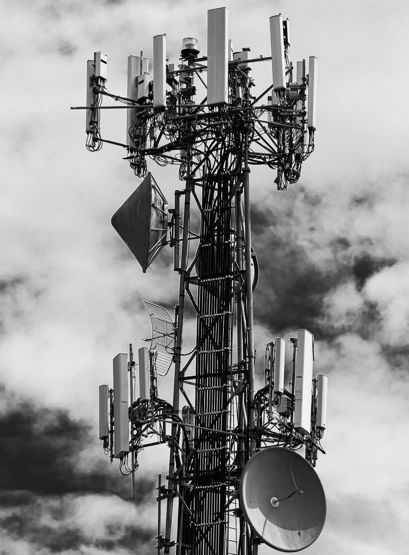An alarm clock connected to a coffee maker that starts making coffee once the clock goes off – this is the most widespread (and quite impressive) example of the internet of things. But, it barely demonstrates the true capabilities of the upcoming tech trend that is nothing less than the AI or 5G revolution.
What is IoT, and what do we need it for?
A device doesn’t need to have a strong processor to be counted as “smart”; it’s enough for it to connect to a device with a strong processor.
The main advantage of the internet is just that. The article you are now reading does not take any of your smartphone’s, tablet’s, or computer’s memory. You have access to it through the internet – just like billions of other articles (thanks for choosing ours, by the way).
That’s what the IoT industry is all about. But why do we need to connect everything to the internet?
Imagine a farmer who installed humidity sensors in his field. After connecting the sensors to the internet, he gets information about humidity levels in real-time and waters the plants only when needed. Therefore, he saves enormous amounts of water and the plants have better chances of surviving.
Now imagine that these sensors are directly connected to the watering systems and independently regulates when and how much to water the plants. Let’s go a step further and connect our system with the weather prognosis. By accounting for rainy days, the farmer uses water even more efficiently, without intervening, saving his energy for much more complex tasks as an additional advantage! Now, this is definitely a more impressive example than our coffee maker connected to an alarm clock.
In simple terms, the main goal of the IoT is to increase efficiency while eliminating waste. Constant monitoring of the results gives us the ability to distribute our resources way more deliberately.
What can be connected to the internet?
The answer to this question is quite straightforward – everything. From concrete to a dog’s collar and toothbrush, almost everything around us can assemble data that we can later label and make use of. In the case of concrete, sensors installed in them inform workers every time there is a crack that could potentially harm the whole construction. As for a toothbrush, it generates and saves information about how often and how well you brush your teeth and then gives you advice on how to do it better. It might surprise you, but there already are working prototypes of the above examples. Even more, the IoT industry is the fastest-growing tech trend:
According to Statista, the IoT market has reached $100 billion in revenue in 2017. It is projected that by 2025 this number will increase to $1.6 trillion.
The fourth industrial revolution
Manufacturing is one of the leading adopters of the Internet of Things. According to Statista, in 2019, half of the existing 620 IoT companies targeted the production industry. One survey found that 71% of American manufacturers are already testing new gadgets in their companies.
German Artificial Intelligence Research Centre (DFKID) is the leading IoT production company in the world. The head of the research center, Detlef Zühlke, states that we are currently on the edge of the fourth industrial revolution.
IoT is mainly used for machine monitoring, task automation, and forecasting. As mentioned above, many believe that this is a huge step forward. Just like PCs and the internet were during the third industrial revolution.
One of the fastest-growing companies in the industry is Bright Machines, which is oriented on micro-factories and works on production automation. In just a year from 2018, it brought in 400 new employees. The startup is run by former representatives of such companies as Autodesk, Amazon, and Flextronics.

Smart homes today, smart cities tomorrow
Here’s where our coffee maker and alarm clock example comes back into play. Smart homes are a fast-growing trend in the U.S.: by the end of 2020, the smart homes market will reach $40 billion while half of the millennials already own a smart gadget. The main reason they’re so impressed with the new tech is its ability to manage things like lights through their phones.
On a broader scale, the biggest advantage of the IoT is saving time. 57% of American users state that technology helps them save at least half an hour a day. That makes up a total of two weeks in one year.
That’s why making the whole cities smarter is the primary goal of many leading countries. Transportation, healthcare, security, customer service… imagine every field you know, connect them, and then connect all of their data to your phone. That’s your smart city—a place where all kinds of information and services are a click away.
How secure is our data?
Obviously, everything isn’t as idealistic as one might assume. One of the biggest threats of the IoT industry is security. It goes without saying that everything that’s connected to the internet can be hacked. No exceptions there.
If we consider the amount of data a hacker can access through our connected devices, the future becomes a little frightening. Leaving hackers aside, many fear legal use cases of our data just as much, like advertising. For example, if you have a sensor in your fridge, a food delivery service can target you when you’re out of food.
But a coin has two sides, and we can use such cases to our advantage as well. For that, it’s essential we have all the information about how tech could manipulate us so that we won’t let that happen. No matter what device we are talking about – The final decision will still always be in our hands.
Commercial use-cases
Apart from high-tech futuristic cases, IoT is probably the most widespread tech on the commercial market. It’s a lot easier to build a connected device than it is to program an AI system, which means that there are many opportunities for the general public here as well.
On Kickstarter, there are 262 ideas under the tag “IoT.” A couple of the most popular ones are a pill tracking box, a vibrations sensor for your door, and a byke sensor that sends you a notification about the whereabouts of your byke in real-time. When we said that you could connect everything to the internet, we meant everything.




What is IoT, and why do we need to connect everything to the internet?
23 October 2020An alarm clock connected to a coffee maker that starts making coffee once the clock goes off – this is the most widespread (and quite impressive) example of the internet of things. But, it barely demonstrates the true capabilities of the upcoming tech trend that is nothing less than the AI or 5G revolution.
What is IoT, and what do we need it for?
A device doesn’t need to have a strong processor to be counted as “smart”; it’s enough for it to connect to a device with a strong processor.
The main advantage of the internet is just that. The article you are now reading does not take any of your smartphone’s, tablet’s, or computer’s memory. You have access to it through the internet – just like billions of other articles (thanks for choosing ours, by the way).
That’s what the IoT industry is all about. But why do we need to connect everything to the internet?
Imagine a farmer who installed humidity sensors in his field. After connecting the sensors to the internet, he gets information about humidity levels in real-time and waters the plants only when needed. Therefore, he saves enormous amounts of water and the plants have better chances of surviving.
Now imagine that these sensors are directly connected to the watering systems and independently regulates when and how much to water the plants. Let’s go a step further and connect our system with the weather prognosis. By accounting for rainy days, the farmer uses water even more efficiently, without intervening, saving his energy for much more complex tasks as an additional advantage! Now, this is definitely a more impressive example than our coffee maker connected to an alarm clock.
In simple terms, the main goal of the IoT is to increase efficiency while eliminating waste. Constant monitoring of the results gives us the ability to distribute our resources way more deliberately.
What can be connected to the internet?
The answer to this question is quite straightforward – everything. From concrete to a dog’s collar and toothbrush, almost everything around us can assemble data that we can later label and make use of. In the case of concrete, sensors installed in them inform workers every time there is a crack that could potentially harm the whole construction. As for a toothbrush, it generates and saves information about how often and how well you brush your teeth and then gives you advice on how to do it better. It might surprise you, but there already are working prototypes of the above examples. Even more, the IoT industry is the fastest-growing tech trend:
According to Statista, the IoT market has reached $100 billion in revenue in 2017. It is projected that by 2025 this number will increase to $1.6 trillion.
The fourth industrial revolution
Manufacturing is one of the leading adopters of the Internet of Things. According to Statista, in 2019, half of the existing 620 IoT companies targeted the production industry. One survey found that 71% of American manufacturers are already testing new gadgets in their companies.
German Artificial Intelligence Research Centre (DFKID) is the leading IoT production company in the world. The head of the research center, Detlef Zühlke, states that we are currently on the edge of the fourth industrial revolution.
IoT is mainly used for machine monitoring, task automation, and forecasting. As mentioned above, many believe that this is a huge step forward. Just like PCs and the internet were during the third industrial revolution.
One of the fastest-growing companies in the industry is Bright Machines, which is oriented on micro-factories and works on production automation. In just a year from 2018, it brought in 400 new employees. The startup is run by former representatives of such companies as Autodesk, Amazon, and Flextronics.
Smart homes today, smart cities tomorrow
Here’s where our coffee maker and alarm clock example comes back into play. Smart homes are a fast-growing trend in the U.S.: by the end of 2020, the smart homes market will reach $40 billion while half of the millennials already own a smart gadget. The main reason they’re so impressed with the new tech is its ability to manage things like lights through their phones.
On a broader scale, the biggest advantage of the IoT is saving time. 57% of American users state that technology helps them save at least half an hour a day. That makes up a total of two weeks in one year.
That’s why making the whole cities smarter is the primary goal of many leading countries. Transportation, healthcare, security, customer service… imagine every field you know, connect them, and then connect all of their data to your phone. That’s your smart city—a place where all kinds of information and services are a click away.
How secure is our data?
Obviously, everything isn’t as idealistic as one might assume. One of the biggest threats of the IoT industry is security. It goes without saying that everything that’s connected to the internet can be hacked. No exceptions there.
If we consider the amount of data a hacker can access through our connected devices, the future becomes a little frightening. Leaving hackers aside, many fear legal use cases of our data just as much, like advertising. For example, if you have a sensor in your fridge, a food delivery service can target you when you’re out of food.
But a coin has two sides, and we can use such cases to our advantage as well. For that, it’s essential we have all the information about how tech could manipulate us so that we won’t let that happen. No matter what device we are talking about – The final decision will still always be in our hands.
Commercial use-cases
Apart from high-tech futuristic cases, IoT is probably the most widespread tech on the commercial market. It’s a lot easier to build a connected device than it is to program an AI system, which means that there are many opportunities for the general public here as well.
On Kickstarter, there are 262 ideas under the tag “IoT.” A couple of the most popular ones are a pill tracking box, a vibrations sensor for your door, and a byke sensor that sends you a notification about the whereabouts of your byke in real-time. When we said that you could connect everything to the internet, we meant everything.
And what idea will you offer us?